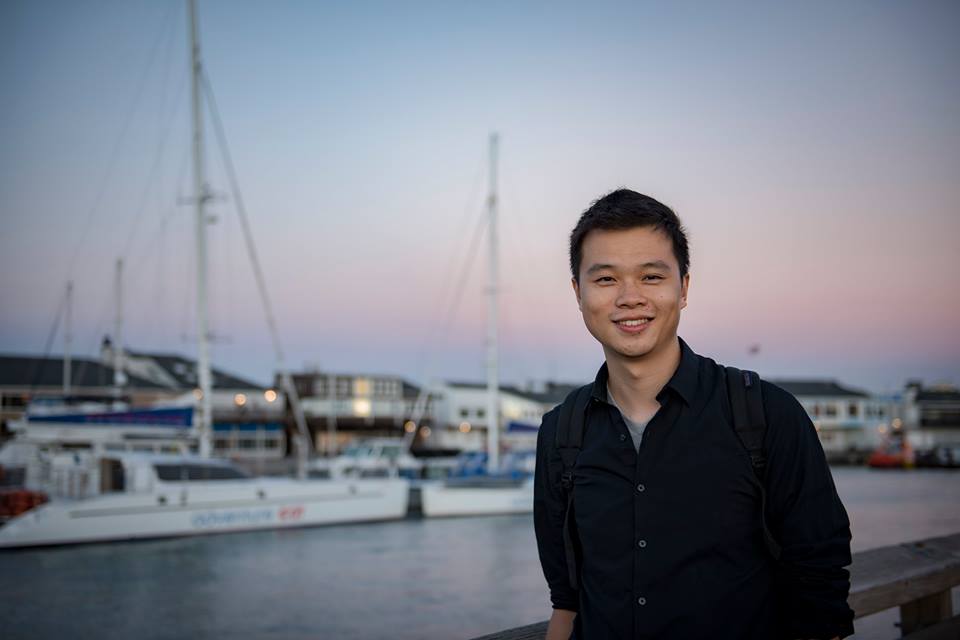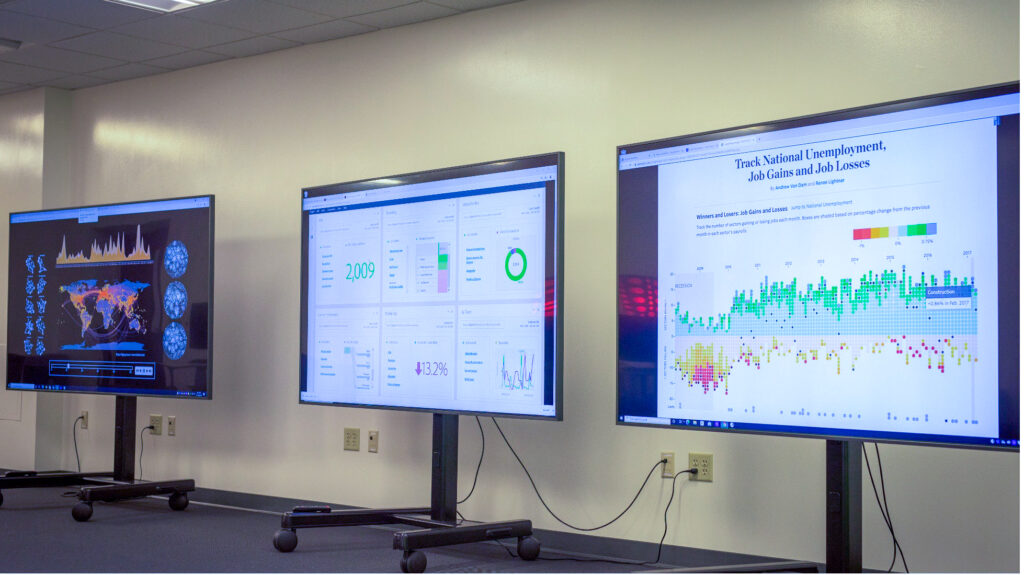There’s something unusual happening in the basement of Johnston Hall. Behind most doors of the historic building are typical classrooms. But in the quiet lower hallway, there’s a learning space that screams unconventional.
Warm oranges and reds are splashed on plush mid-century modern chairs scattered throughout the 1,100-sq.-ft. collaborative workspace. Corner lamps with bright red shades illuminate the white walls, and six high-performance workstations are topped with computer monitors. There are three, 86-inch 4K display screens that can be wheeled around the room on which students are able to project content from their personal devices — be it phones or laptops — onto the large screens for shared endeavors.
The Diederich College of Communication’s Artificial Intelligence for Analytics and Insights Lounge, or Ai4Ai Lounge, was designed by Dr. Larry Zhiming Xu, assistant professor of strategic communication.
“Inaugurated in 2022, Ai4Ai operates under the joint sponsorship of the Diederich College of Communication and Northwestern Mutual Data Science Institute,” Xu says. “The lounge is designed to foster a synergistic environment where students can learn how to effectively transform data analytics into actionable insights.”
Data science is a new force in the communication field, and it shows no signs of stopping. Xu teaches his students about the applications of data analytics in various contexts, including sentiment analysis for gauging public opinion on social media, network analysis to map community structures and to pinpoint influencers, and predictive analytics to guide strategic planning. Most recently, he explored the capabilities of large language models for generating and curating content.

“A cornerstone of my teaching approach is equipping students with the skills to translate data analytics into visually engaging dashboards and logically coherent narratives. In alignment with this focus, the Ai4Ai has been specially designed to offer advanced visual capabilities,” Xu says.
Gwen Viegut is in her last semester of graduate school and is studying digital communication strategy. One of Xu’s former students, Viegut points out that data science and communication work seamlessly, especially through AI.
“It’s like trying to teach an alien how to be human. You have to be able to understand communication and break it down to its most elementary form to be able to input and teach an AI model.” Viegut says. Machine learning is trying to imitate the process of the human brain. AI is often trying to find the most efficient ways of processing and communicating data, but it can’t do that unless it learns how to communicate properly,”
Abdallah Alqaoud, Grad ’23, got his master’s degree in communication, and believes that artificial intelligence is the future not just for communication but for all industries.
“As we slowly move toward a more virtual world with increased developments in virtual and augmented reality technologies and content streaming, now is a crucial time for students to understand AI and how it can be implemented. This technology serves as a great tool for communication students and professionals to help with data collection and calculations,” Alqaoud says.

Misconception vs. truth
The Ai4Ai Lounge is helping to dispel the common stereotype that communication students are typically math averse.
“The reality is that data informs communication strategy and decision making. Communication professionals and researchers rely on data to understand the impact of messages and the behaviors of stakeholders,” says Dr. Sarah Feldner, dean of the Diederich College of Communication. “At the same time, numbers do not speak for themselves. Communication plays a key role in extracting insights from data and making it actionable.”
The constant evolution of communication makes the college’s partnership with data science essential — the reason the Ai4Ai Lounge was created.

“Because our professions and practitioners are increasingly looking to data for developing strategy, we wanted to make sure our students had access to the tools, perspectives and technology,” Feldner adds. “Having a space where students can work collaboratively and work with students from across areas creates opportunities for students.”
Peering into the future, Xu says that change in the AI and communication fields will be constant. He says technology is happening so rapidly that it’s hard to predict even what next month looks like, and that science and communication will be forever intertwined.
“Over time, I expect AI to become so ingrained in our daily lives that we may cease to explicitly label it as such, much in the same way that we have stopped labeling every computer-powered technology as ‘computer-based,’” Xu says. “I think one thing that won’t be easily affected (or determined) by AI would be our moral compass that helps us tell what is ethically right or wrong.”




